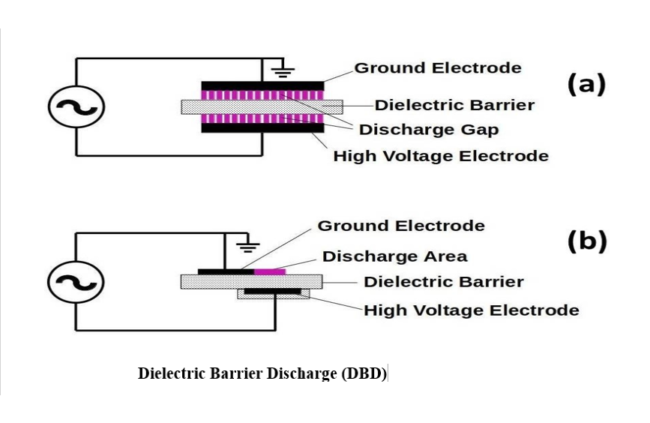In physics, the term “Plasma” refers to a quasi-neutral ionized gas, or a gas in which a specific percentage of particles are charged. Plasma becomes a highly conductive gas that reacts quickly to electromagnetic fields when charged species are present. Because of its significant differences from the properties of the solid, liquid, and gaseous states of matter, plasma is also referred to as the “fourth state” of matter. At present, plasma has proven to be a biggest wonder towards technological applications. Plasma technology is commonly used in many industries, including in the automotive, microelectronics, packaging, medical device industries, materials processing and pollution control etc. The most important practical applications of plasmas lie in the future, largely in the field of power production.It can help make features on chips for computers. Plasma is also used in making transmitters for microwaves or high temperature films. It can even be used in work with minerals such as diamond, and in extracting economically valuable metals from rock. Plasma technologies have a wide range of applications, from creating stunning neon signs to propelling spacecraft. In the semiconductor industry, plasma processes are critical for manufacturing high-quality electronic devices with precision and efficiency. The multidisciplinary field of plasma medicine focuses on the therapeutic uses of plasma, or ionized gas, including wound healing, cancer treatment, and disinfection. Here, a form of plasma in terms of dielectric barrier discharge is discussed towards pollution control.
Types of plasma:
Plasma can be divided into two categories i.e., natural plasmas and artificial plasma. Natural plasmas exist in the nature (not at earth) at high temperatures in the universe. Plasma does not occur on earth as human cannot survive at the temperatures required for natural existence of plasmas. Because 99.9% of all mass in the universe is plasma and that is why it is also called “fourth state of matter”. Naturally, plasma exists in stars, Aurora Borealis, ionosphere, lightening, Elmo’s Fire etc. Man has made possible to make plasma artificially at earth for its various applications like in Neon & Fluorescent Light Bulbs, plasma televisions, plasma globe, Lightsabers, plasma arcs, plasma cutters, plasma torches etc.
Generation of Plasma:
There are various types to generate plasma like, heating a neutral gas or subjecting it to a strong electromagnetic field and by applying external electric field (electrical discharge). We will discuss some of them like low temperature and atmospheric pressure plasma based on convenient to use and generating processer of electrical discharge.
Types of Generated Plasma:
• DC Discharge Plasmas
• RF Discharge Plasmas
• Capacitive Coupled Plasmas
• Inductively Coupled Plasmas
• Microwave Discharge Plasmas
• Arc Discharge Plasmas
• Corona Discharge Plasmas
• Atmospheric Pressure Plasma Jet (APPJ)
Dielectric Barrier Discharge (DBD):
With a series of unique advantages of being prone to chemical reactions, low power consumption, simple construction and atmospheric operation at room temperature, the DBD plasma technology has been widely used in the synthesis and modification of various nanomaterials. Dielectric Barrier Discharge (DBD) is a discharge that occurs when an AC voltage is applied to one or both of the electrodes made of two metal plates and covered with an insulator. The insulator works in the same way as a capacitor. For this reason, insulators are also called dielectrics. A dielectric barrier discharge also requires the presence of several insulating layers in the current path across metal electrodes in the discharge space. Dielectric-barrier discharges (DBDs), also referred to as quiet or inaudible discharges or barrier discharges.
Properties of DBD:
• Non thermal equilibrium nature:
Non-thermal plasmas require less power and can be produced at lower pressures. They exhibit a local thermodynamic equilibrium because they have an electron temperature that is significantly greater than the gas’s (macroscopic temperature). In gases with lower pressure, electric discharges can produce this kind of plasma. These discharges are appropriate for material processing since they do not reach thermal equilibrium.
Micro Discharge:
The most interesting property of DBDs is that in most gases at about atmospheric pressure breakdown is initiated in a large number of independent current filaments or micro discharges. Generally, micro-plasmas have the prospect of being used in various medical and industrial applications including: sterilization, medical treatment of human skin, surface activation, nano-material synthesis, and thin film coating.
Applications of DBD:
1. Ozone Generation
2. Plasma Display Panels
3. Plasma in Agriculture
4. Surface Modification and Coating
5. Plasma in Medical
6. Plasma Ignition
7. Plasma in Pollution Control
8. CO2 Lasers
9. Incoherent Excimer Ultraviolet Sources


